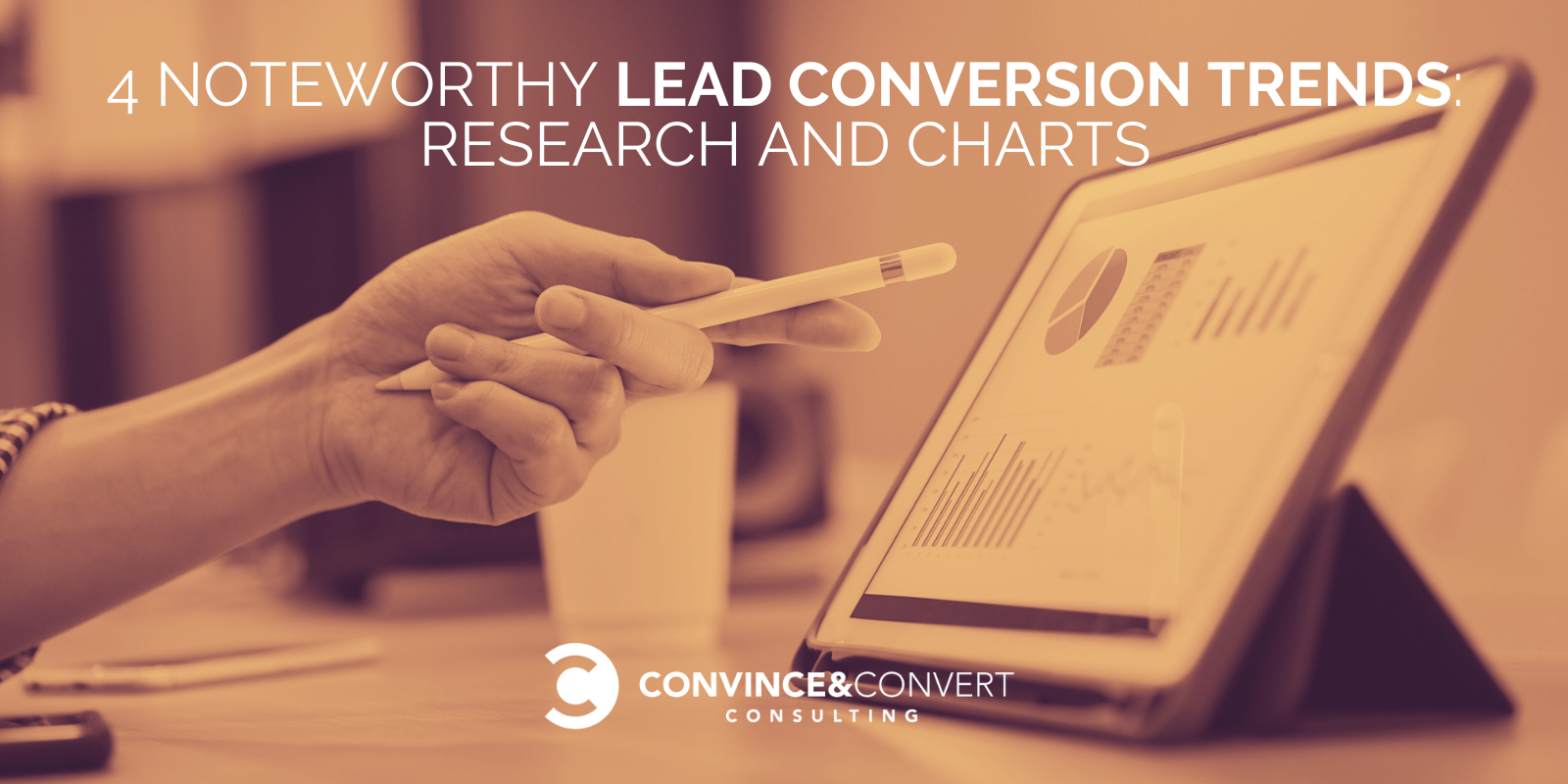
With a myriad of marketing tactics at our disposal, cool marketing technology that can track performance and automate campaigns, and countless strategies and processes to optimize marketing, sometimes we can’t see the forest for the trees.
For many marketers, we think in terms of leads (impersonal, just a number) and not relationships (personal and real). Sometimes we miss the obvious: successful marketers build relationships. We must remember that a lead is a real person, and to be a successful marketer, we need to build a relationship with prospects.
A new research study by Ascend2 is Building Relationships for Lead Conversion. The survey was fielded the week of June 8, 2020, and a total of 263 marketing professionals participated.
Considerable shifts in the way businesses operate are leading marketers to re-examine the way they approach lead generation. Building meaningful connections with buyers is now a critical part of generating and nurturing leads that convert.
How are marketers building relationships for maximum lead generation and conversion?
Here are a few noteworthy findings from the Asend2 research study, as well as insight from marketing professionals.
1. Marketers are struggling to generate enough relationships as they shift marketing efforts to more digital-forward initiatives.
Half (50%) of marketing professionals report struggling to generate enough relationships as they shift marketing efforts to more digital-forward initiatives. Building meaningful relationships with new and existing leads requires appropriate allocation of budget and resources, which 42% of marketers report is a top challenge for lead generation success.
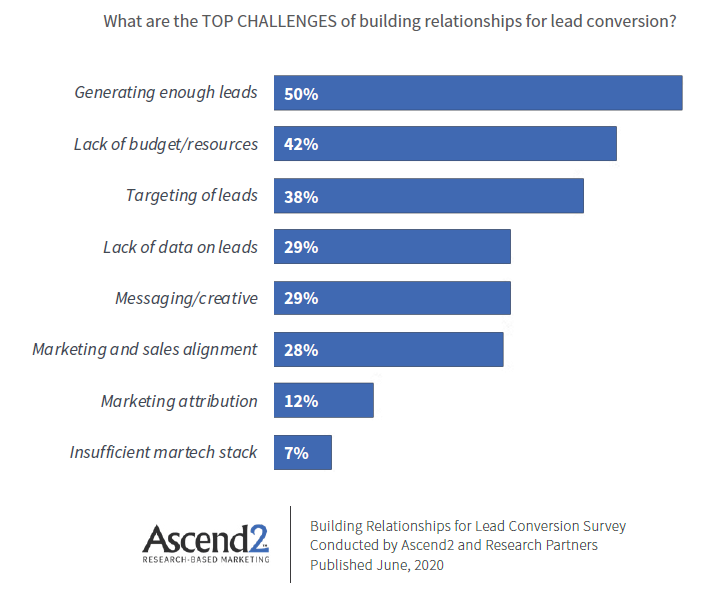
Top Challenges of Building Relationships for Lead Conversion

Jeff Haws, Senior Marketing Manager, MessageGears
How can you generate stronger relationships? An important first step is to know more about your ideal audience and give them something of value based on their needs.
Jeff Haws, Senior Marketing Manager at MessageGears, explains, “one of the keys to effectively building relationships is to identify your ideal audience and tailor your messaging and targeting to them. Eliminate as much noise as possible by developing a laser focus on those people who will benefit the most from your unique value, and make sure marketing and sales are on the same page about who those people are.”
2. Social media, email marketing, and website/SEO lead the way as the most effective channels for building relationships for lead conversion.
Social media (58%), email marketing (49%), and website/SEO (44%) lead the way as the most effective channels for building relationships for lead conversion. Developing an overall strategy of how all of your marketing tactics connect and work together as part of the customer journey is an important step to building stronger relationships.
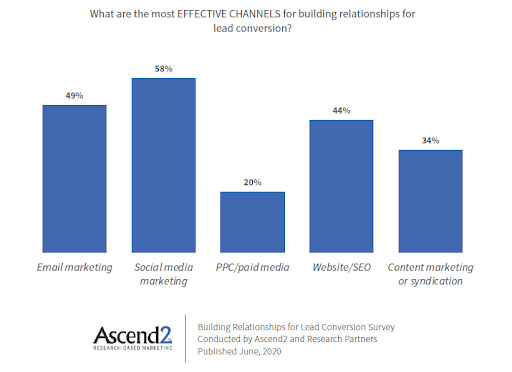
Most Effective Channels for Lead Conversion

Mike Grehan, CMO & Managing Director, Acronym
It is helpful to consider the customer journey when looking at channels. The customer journey is the complete sum of experiences that customers go through when interacting with your company and brand. Where does the journey start? Where does the journey end?
According to Mike Grehan, CMO & Managing Director at Acronym, “the customer journey most frequently starts with search and very often ends with search. Many brands are loaded with content for the transactional part, but seem to lack content for the early stage. This is why SEO is still so important. Well-crafted and optimized content for answering questions and solving problems creates brand affinity much earlier instead of trying to battle for attention at the checkout.”
3. Content in video format is most effective at building relationships to generate leads that convert.
When building loyalty and trust with an audience to build relationships, creating and distributing content is essential. Forty-one percent (41%) of marketing professionals agree that content in video format is most effective at building relationships to generate leads that convert. Educational content types such as webinars and original research are also effective, according to 36% of those surveyed.
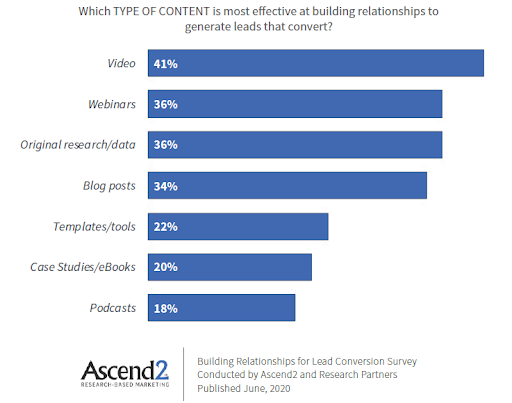
Most Effective Content Types for Lead Conversion

Rameez Ghayas Usmani, Digital Marketing Executive, PureVPN
There are many format options to consider. Rameez Ghayas Usmani, Digital Marketing Executive at PureVPN explains, “written content is undoubtedly useful, but today, visual materials such as infographics or videos are outperforming for marketing and relationship building purposes, and they will continue to be one of the most frequently used marketing strategies for 2020.”
Dan Bailey, President at WikiLawn shares another content strategy. “Our lead generation strategies now focus on providing free, high-value content as part of a sales funnel. We create articles, videos, and other content, and put that content behind a landing page where the user has to enter their email address to get access. We run Facebook ads to direct people to this landing page, and once they’re on our list, we continue to build a relationship with them.”
4. Lead generation budgets are being redirected to social media and website/SEO improvement.
Many marketing dollars previously allocated to in-person events and direct marketing efforts are being redirected. Over half of marketers say that much of their lead generation budgets will be attached to social media (54%) and website or SEO improvement (51%). Another 44% report that email or automation will account for a significant amount of budget in the year ahead.
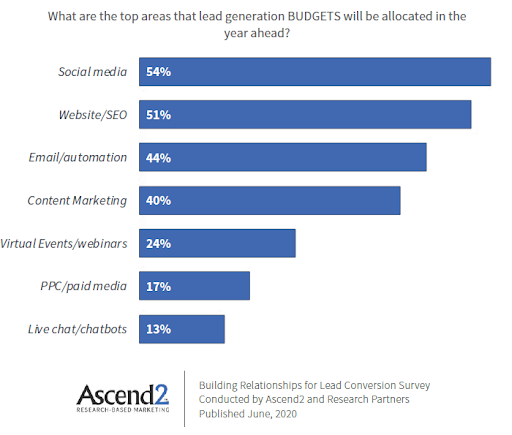
How Lead Generation Budgets Will Be Allocated
Building relationships is especially challenging right now with the cancellation of live events and employees working remotely. How can you replace that face to face experience?

Joaquim Miro, Chief Growth Officer, Hoppin’ World
Joaquim Miro, Chief Growth Officer at Hoppin’ World, said that “being able to be face-to-face with a prospect is always the best way to convert them into a client. Therefore, looking for options that allow this to happen remotely is an important next step.”
Use technology to do virtually what you would do in person: train, give guided tours, have Q&A sessions, and more. Be creative to build a relationship with your prospects and don’t let challenges stand in your way.
How are companies reallocating their budget?
Quincy Smith, Founder of ESL Authority, reveals how his organization is shifting budgets. “We’ve reallocated our in-person budget (previously used for job fairs, campus visits, etc) into online retargeting,” said Quincy. He continued, “we’ve always had significant organic traffic, but are only now attempting to retarget it given that we cannot do much in person. So far it’s very much trial and error, we’ve done paid ads before but not for this purpose so we’re still testing messaging, platforms, and imagery.”

Sunny Ashley, CEO, Autoshipinvoice
Sunny Ashley, CEO at Autoshipinvoice, has moved a bulk of its marketing budget and efforts to SEO and content marketing. Sunny explains, “there are 3 main reasons why: 1. SEO can be done relatively cheaply, for the cost of time and labor in writing content. 2. SEO best practices are ever-evolving; this means there is always something new to learn. Since marketing now has more time and flexibility without the need to plan for physical events, now is the time to try new SEO techniques and experiments. 3. SEO takes time. If direct marketing methods aren’t as effective right now while our customers have less budget, now is a great time to build a catalog of content that will grow in influence over the coming months. As business begins to return closer to normal, our SEO efforts will hopefully be peaking.”
Joaquim, Quincy, and Sunny are all finding ways to understand their target audience, reallocate budget based on what is working, and focusing on building relationships that convert.
Conclusion
Building relationships takes time. Marketers need to listen to their prospects, analyze the data, test new tactics and strategies, optimize existing tactics and strategies, and be flexible and agile in what you do to build relationships that convert.
Here is a link where you can download the entire report, Building Relationships for Lead Conversion.
The post 4 Noteworthy Lead Conversion Trends: Research and Charts appeared first on Content Marketing Consulting and Social Media Strategy.
from Content Marketing Consulting and Social Media Strategy https://ift.tt/2XmH7Mg

No comments:
Post a Comment